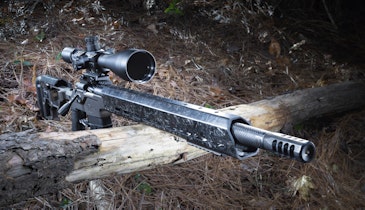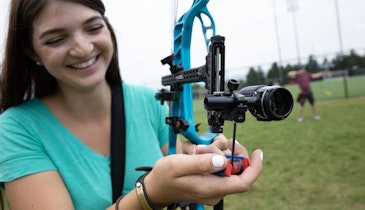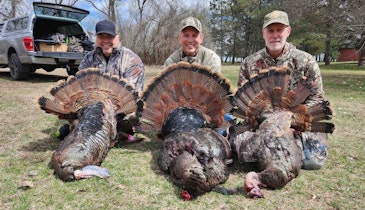For the past two hunting seasons, my son-in-law David and I have aggressively hunted a piebald doe in order to take her out of the local deer herd on my Botetourt County, Va., land. While afield with a crossbow this past October, I finally killed the piebald. I then e-mailed Lindsay Thomas, Jr., director of communications for the Quality Deer Management Association (QDMA), to tell him how happy I was concerning my betterment of the deer herd. To my amazement, this is what he wrote back.
“There really are not any deer that must be removed from the herd to avoid population problems,” he said. “This is actually a misconception we’ve been fighting, especially as it pertains to the idea that hunters can shape genetics in free-roaming deer. We can’t.
“It seems like good logic that if you shoot a deer, it can’t breed anymore, and therefore its genetic profile will fade,” Thomas wrote. “It just doesn’t work that way with free-roaming deer. There’s too much gene flow across the landscape for hunters to have an influence. Basically, you should strive to kill the right numbers of does for your situation if necessary, and strive to kill bucks that meet your particular age-based goal. Other than that, ‘culling’ is not something we promote. I don’t even like to use the word ‘cull.’ ”
With Thomas’ comments in mind, let’s take a look at some of the management issues deer hunters/landowners face.
Can We Keep Button Bucks From Leaving A Property?
James Hancock owns and manages a 300-acre Virginia property. He is also an independent contractor for wildlife habitat improvement projects, as well as being the vice president of the Roanoke QDMA branch. This past season, Hancock asked me to come over to his land to help him kill a mature doe that had one offspring, a button buck, and that also had a very defined evening travel itinerary. A half hour after climbing into a stand James had selected, I passed on the juvenile male and arrowed his mother. Hancock explained his reasoning for wanting to kill mature does.
“The research shows that button bucks are more likely to stay put if we shoot their mothers,” he said. “Sooner or later, a doe is going to force her male offspring to leave the area where he has grown up, where he knows where the food is, and where he knows where to go to be safe. When that button buck leaves his home area, his odds for survival greatly decrease and we land managers will never see him again. And the efforts that we undertook to provide that young buck nourishment and sanctuaries will have been wasted.
“This past hunting season, one of my objectives was to kill more mature does on my own land in order to keep their button bucks here,” Hancock continued. “I was tired of seeing young bucks that I had watched all summer and early fall disappearing and being replaced by button bucks that had wandered here and were much smaller in size than the ones that had left.”
Hancock emphasizes that retaining button bucks is particularly important for the landowner/property manager who practices QDM. That it’s quite likely that the yearling dispersers which are replacing the button bucks born on QDM property lack the body weights and potential of the ones that have left.
Should We Target Late-Born Fawns?
Last December during the Old Dominion’s late muzzleloader season, Hancock asked me to join him for a hunt on one of the properties he manages. We hunkered down in an abandoned chicken coop that adjoins a clover food plot that numerous whitetails were visiting every evening. Our mission was to kill a late-born doe fawn that was incredibly small for the time of year.
“I do believe that it is a benefit to the herd as a whole to kill late-born fawns,” he said. “They are consuming food that could go to other members of the local deer herd. And chances are that their growth rate will take years, if ever, to catch up to other deer of their age.
“I just finished reading the book ‘Mountain Sheep: A Study in Behavior and Evolution’ by Valerius Geist,” Hancock continued. “In it, he details how young rams that experience plenty of food and mild winters their first two years of existence will gain an advantage over those rams that experience the opposite — an advantage that the latter rams never overcome. I believe the same principle applies to deer.”
On our outing, a mature doe, a button buck and the aforementioned late-born doe fawn were the only whitetails to enter the food plot. We observed the trio for some 30 minutes before I finally had a shot that I felt comfortable with. After the smoke cleared, we saw that the doe fawn had only traveled a few yards. It was one of the smallest whitetails I have ever killed.
“With the lack of mast and how cold it’s been already, that doe fawn was in for a hard winter, if she survived it at all,” he said. “I want to emphasize that what we did has nothing to do with the genetics of the local deer herd, as killing that late-born fawn will not affect the herd’s genetics one bit. In fact, she could have had a better genetic background than the two deer that you didn’t shoot.
“That doe fawn was a victim of being born too late during a poor mast year and a hard winter,” he said. “I think she is also a good example of why we land managers should strive to have a buck-to-doe ratio that is right for our particular properties. Late-born fawns don’t often happen when the buck-to-doe ratio is in harmony with the environment. Then the vast majority of fawns are born at the right time and are less likely to be victims of predators as well because the area is flooded with fawns.
“In the North and Upper Midwest, cold snaps, late blizzards, and hard winters take care of late-born fawns. In much of the rest of the country, I think it’s good for us land managers to help with this situation,” Hancock said.
Interestingly, last year in southwest Virginia, I observed fawns with spots as early as May 17 and as late as November 21. Ideally, that disparity shouldn’t happen, as does should drop their fawns in late May and early June in the Mid-Atlantic.
By the way, you can contact James Hancock at jameshancock204@gmail.com.
Can We Reduce The Doe Population So Much That Our Bucks Will Leave?
Two deer managers have recently told me that hunters/land managers can reduce the doe population so much that the local bucks will leave a property. Is that scenario a possibility or another misconception?
“Yes, bucks search for does during the rut, and bucks do tend to end up in areas where the does gather,” said Lindsay Thomas. “But they don’t abandon their home range and move to a new area because there might be more does somewhere else. Adult bucks are extremely loyal to their established home ranges. So don’t try to stockpile does to attract bucks if it means exceeding the carrying capacity of the habitat, but at the same time there’s no good reason to shoot so many does that you take the herd below carrying capacity.”
To show how loyal bucks can be to their home ranges,Thomas cites a study where deer on an island had to leave it when a flood inundated the land mass. Nevertheless, several bucks refused to leave and succumbed to the rising water, and every buck that left returned when the waters receded.
Should We Target Injured Or Deformed Deer?
Several years ago during the rut, I targeted a buck fawn that only had three healthy legs and limped badly when I first observed it while afield on my land. I devoted a morning to trying to kill the whitetail and eventually succeeded. Was I right to have done so, or did my actions really matter?
“It’s usually a personal decision on whether we should try to kill an injured or deformed deer,” said Thomas. “We may say to ourselves that we are doing a good thing by putting an animal out of its misery. But deer are extremely resilient. They survive and even thrive despite all kinds of injuries. I’ve seen cases of three-legged does that successfully raised fawns and eluded predators. I’ve seen trail-camera photos of a three-legged buck working scrapes and chasing does. But there are other times when we know that deer are seriously injured and probably won’t survive. Again, it’s a personal decision on what to do in each case.”
Does Such A Thing Exist As The Ideal Doe To Buck Ratio?
I also asked Thomas if there is such a thing as the ideal doe-to-buck ratio.
“No, there’s not,” he said. “The doe-to-buck ratio varies from season to season, but usually we are talking about a pre-hunting-season ratio, [meaning] after that year’s fawns have entered the population but before hunters start hitting the woods. Some people believe a 1:1 doe-to-buck ratio is ideal, but that’s actually not easy to achieve. If you can reach a pre-hunt ratio of around or a little below 2:1, that’s a good place to be.
“You can get there by doing two things,” Thomas counseled. “First, if it is necessary, simply take the right number of does so that the population does not exceed the carrying capacity of the habitat, which is the number of deer that can be supported in healthy condition. Second, protect most yearling bucks so you build numbers of adult bucks in the population.”
Today, one of the most wonderful and important aspects of being a landowner and deer hunter is the knowledge that exists so that we can make better decisions. Never before has so much research and information been available to help guide us. I know now that my killing of the piebald meant nothing in the overall scheme of things, except that the venison from her will help feed my family this year — and that’s something to celebrate.
For more information on the Quality Deer Management Association: www.qdma.com.






